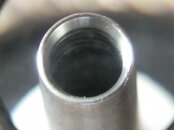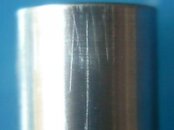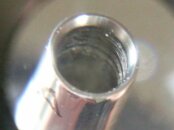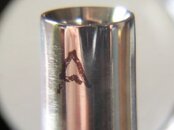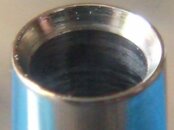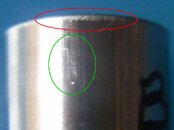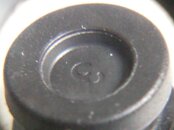Zung
Contributor
Thank you gentlemen for your encouragements.
On to the real deal: I cured my MK20 #2 the "professional way" by replacing the piston, so I have the old one on hand, and I have this MK25 #3 that has an instant swing to 8 bar / 116 PSI, then a 1 min. creep to 9 bar / 131 PSI. OK, but not nice.
The "dead" piston is a current generation composite with a stainless steel shaft. Looking at the knife edge with a 15x and a 20x loupe, I can't see anything wrong (MK25#3-Before-01.jpg). But the side is a different story: there are quite a lot of very fine scratches that are not visible with the nake eyes, but very obvious with the loupe, given the proper lighting (MK25#3-Before-02.jpg).
Working the mattmagic on stainless steel is a lot harder than brass. I have to start with the 1500 grit to remove the scratches, and work my way up to 8000 grit, checking often with the loupe. After nearly an hour, I got fed up and call it a day. The thing looks good (...-After-01 & -02.jpg), even when compared to a new one (...-New.jpg), but my confidence is very low.
Using the alternative assembly procedure, I simply removed the original piston of the #3 from above, and plug the "revived" one straight in, turn on the air, and, to my surprise, IT WORKS! After less than a dozen purges, it lockups at 9.4 bar / 136 PSI and stays there. Recovery takes a second or less, and an hour later, it's still there.
Regarding herman's question, here's what I have at low air situation: tank pressure vs IP (bar/PSI)
150/2175: 9.4/136
125/1813: 9.4/136
100/1450: 9.4/136
85/1233: 9.4/136
70/1015: 9.4/136
60/870: 9.4/136
50/725; 9.3/135
40/580: 9.2/133
25/363: 9.1/131
15/218: 6.4/93
At pressure below 60 bar / 870 PSI, when the IP starts to drop a little, the lockup is less snappy and takes maybe a couple of seconds.
I'll leave the reg on for a couple of days and report back if there's any change. For now, it looks like there's a life after death. And you know what? I've very happy!
On to the real deal: I cured my MK20 #2 the "professional way" by replacing the piston, so I have the old one on hand, and I have this MK25 #3 that has an instant swing to 8 bar / 116 PSI, then a 1 min. creep to 9 bar / 131 PSI. OK, but not nice.
The "dead" piston is a current generation composite with a stainless steel shaft. Looking at the knife edge with a 15x and a 20x loupe, I can't see anything wrong (MK25#3-Before-01.jpg). But the side is a different story: there are quite a lot of very fine scratches that are not visible with the nake eyes, but very obvious with the loupe, given the proper lighting (MK25#3-Before-02.jpg).
Working the mattmagic on stainless steel is a lot harder than brass. I have to start with the 1500 grit to remove the scratches, and work my way up to 8000 grit, checking often with the loupe. After nearly an hour, I got fed up and call it a day. The thing looks good (...-After-01 & -02.jpg), even when compared to a new one (...-New.jpg), but my confidence is very low.
Using the alternative assembly procedure, I simply removed the original piston of the #3 from above, and plug the "revived" one straight in, turn on the air, and, to my surprise, IT WORKS! After less than a dozen purges, it lockups at 9.4 bar / 136 PSI and stays there. Recovery takes a second or less, and an hour later, it's still there.
Regarding herman's question, here's what I have at low air situation: tank pressure vs IP (bar/PSI)
150/2175: 9.4/136
125/1813: 9.4/136
100/1450: 9.4/136
85/1233: 9.4/136
70/1015: 9.4/136
60/870: 9.4/136
50/725; 9.3/135
40/580: 9.2/133
25/363: 9.1/131
15/218: 6.4/93
At pressure below 60 bar / 870 PSI, when the IP starts to drop a little, the lockup is less snappy and takes maybe a couple of seconds.
I'll leave the reg on for a couple of days and report back if there's any change. For now, it looks like there's a life after death. And you know what? I've very happy!
Attachments
Last edited:




